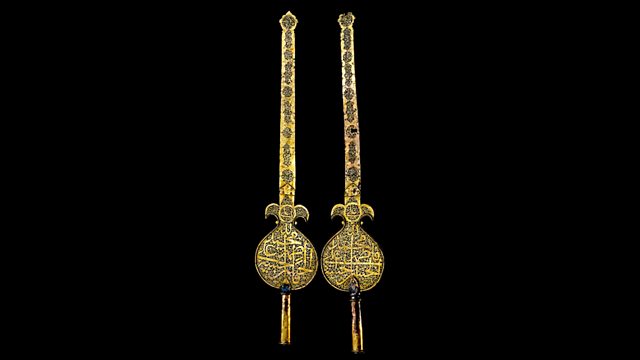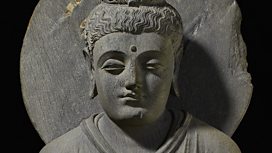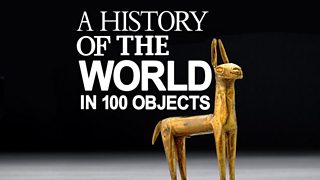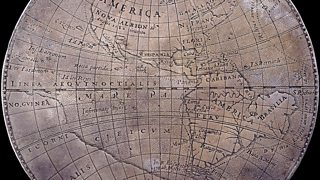Shi'a Religious Parade Standard
Neil MacGregor explores the co-existence of faiths around 400 years ago. Today, he is with one of the great standards that were used in Iran, carried at Shia processions.
Neil MacGregor's world history as told through things. This week he is exploring the development and co-existence of faiths across the globe around 400 years ago, looking at objects from India and Central America, Europe and Indonesia that embody the political consequences of belief.
Today, he is with a remarkable object from Shia Iran that in the 16th century was open to the co-existence of faiths. The object he has chosen is a symbol of Shia faith, a standard or Alam that was carried at the front of Shia processions. They were often so tall and heavy that they would require great physical strength to handle. Neil visits religious sites in Isfahan to reflect on the spiritual climate of the time. Hossein Pourtahmasbi, from the Iranian community in London and a former alam carrier, describes the tradition. And the Iranian historian Haleh Afshar reflects on the shifting position of Shia Islam within Iran over the centuries.
Producer: Anthony Denselow
Last on
More episodes
Previous
You are at the first episode
![]()
Discover more programmes from A History of the World in 100 Objects about religion
About this object
Location: Iran
Culture: Islam
Period: Late 17th century
Material: Metal
��
Standards like this were used in religious processions in Iran 400 years ago. It was during this period that Iran changed from being a Sunni Islamic state to a Shi'a Islamic state. This standard is in the shape of the sword of Imam Ali - the husband of Fatima, daughter of the Prophet Mohammad. Shi'a Muslims believe that Imam Ali is the true successor to the Prophet. This sword is inscribed with the names of the Prophet, his family and the twelve Imams revered in Shi'ism.
Who were the Safavid dynasty?
The Safavid shahs ruled Iran from 1501 to 1722. They claimed to be the descendants of the Prophet Muhammad. Under their rule Iran became the world's largest Shi'a state and Shi'ism developed many of the forms and practices still dominant today. Standards like this were originally used in battle to indicate the presence of the ruler but were adopted for use in religious processions during the Safavid period.
Did you know?
- Safavid ruler, Shah 'Abbas is credited with starting an Iranian fashion for wearing a moustache.
Meet the Safavids
By Fahmida Suleman, curator, British Museum
��
The Safavids ruled Iran between 1501 and 1722. The origins of the dynasty date back to the 1300s to Shaykh Safi al-Din (d.1334), a Sufi master, or Muslim mystic, who lived in the town of Ardabil, in northwest Iran. Shaykh Safi was a popular holy figure who attracted a significant following of dervishes and upon his death he was buried in a shrine at Ardabil.
Although the dynasty began as a peaceful mystical order in northwest Iran, it gradually acquired a military and political dimension which reached its peak under the leadership of a charismatic young man called Ismail Safavi. By this time, at the end of the 1400s, the Safavid mystical order had grown both in power and in numbers and was threatening the political sovereignty of the Turkman dynasty, the Aq Qoyunlu, ruling western Iran at the time.
Ismail Safavi had gained his military support from Turkmen tribesmen originating from eastern Anatolia and Syria who were called the Qizilbash – literally ‘red heads’ – on account of their distinctive red caps. The Qizilbash were fervent supporters of their leader and in 1501 they succeeded in defeating the Aq Qoyunlu thereby wresting control of northwest Iran and crowned Ismail Safavi as Shah Ismail, the first Safavid ruler (r.1501–24).
The reign of Shah Ismail, who was barely 14 years old at the time of his accession, was a turning point in Iran’s history as he proclaimed Shiism, specifically Ithna ‘Ashari or Twelver Shiism, as the state religion, and it has remained so to the present day. During his reign, the dynasty united the eastern and western halves of Iran.
One of the greatest Safavid rulers famed for opening up Iran’s borders to international trade and diplomacy was Shah ‘Abbas I (r.1587-1629).
In 1598 Shah ‘Abbas moved the capital and all his courtiers from Qazvin to his newly-built magnificent city of Isfahan. The centre of Isfahan was a massive rectangular maidan, or piazza, surrounded by royal palaces, gardens, opulently tiled mosques, and arcaded bazars. The Shah settled large numbers of courtiers, Armenian merchants and craftsman within his thriving metropolis in order to drive his ambitions for a booming economy based in part on the luxury silk trade.
Indian and European travellers, diplomats and traders were welcomed to Isfahan, while the city also became a magnet for fashion-conscious youths who advertised the empire’s wealth and success by donning exquisite costumes made of Isfahani silk.
The decline and eventual fall of the Safavid dynasty was set in motion following the death of Shah ‘Abbas. His grandson and successor, Shah Safi (r.1629-42), intent on maintaining his position put to death or blinded possible rivals. His son and successor, Shah ‘Abbas II (r.1642-66), was a more competent ruler but he was less able to withstand pressure from his religious leaders.
The last two Safavid Shahs were weak and pliable rulers and gradually the administration and military strength of the Safavids weakened to such an extent that in 1722, a small band of marauding Afghans succeeded in starving the Safavid capital into surrender.
To be a strong man is not enough
By Hossein Pourtahmasbi
��
Usually the person who carries the Alams is in the front of his people, the group which goes from one mosque to another mosque. First of all you have to be a good weight lifter because its quite heavy, it sometimes goes up to 100 kilograms, but its not just a matter of 100ks weight it’s the balancing and the shape of the Alam which is huge and wide and as you start to walk it can bounce and take you down and damage your back and discs – you have to be very physically fit for that and the people are either wrestlers or weight lifters and strong and well known by that society.
But to be a strong man is not enough, in that community the people have got to know you as well because it’s sort of tradition to give you admission. It’s keeping the memory alive, for the kind of rights you have to fight and it keeps you strong, you keep singing the songs, keeping the tradition and carry on.
Transcript
Broadcasts
- Mon 27 Sep 2010 09:45�鶹������ҳ��� Radio 4 FM
- Mon 27 Sep 2010 19:45�鶹������ҳ��� Radio 4
- Tue 28 Sep 2010 00:30�鶹������ҳ��� Radio 4
- Mon 6 Sep 2021 13:45�鶹������ҳ��� Radio 4 FM
Featured in...
![]()
Religion—A History of the World in 100 Objects
A History of the World in 100 Objects - objects related to religion.
Podcast
-
![]()
A History of the World in 100 Objects
Director of the British Museum, Neil MacGregor, retells humanity's history through objects





